Update date: June 27, 2017
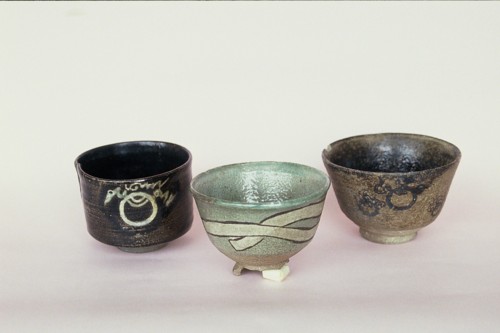
Tamagawa-yaki green tea bowl
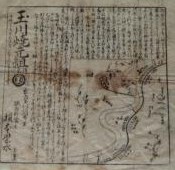
Promotional leaflet for Tamagawa ware
History of Tamagawa ware
Sakahama Koshoji Temple Near Enomoto The house has a collection of pottery called "Tamagawa-yaki" that was fired in this area in the late Edo period. The Enomoto family has been a farming family in Sakahama village for generations. Rihei ( Genroku Since the time of the 1950s, he has been making clay from the surrounding area during the off-season. Earthenware teapot Mortar and pestle Miscellaneous items It is said that they used to bake Shop name It was called "the fourth generation of Rihei He went to Seto and Kyoto to study pottery, mastering the local pottery-making techniques. Tenpo In 1834, he returned to Sakahama village and started making pottery in Inagi. Jade seal He started making Tamagawa-yaki, which he called his trademark, and did a brisk business. Shisui Enomoto And Chofuken Shisui I use the number.
According to a woodblock-printed flyer advertising Tamagawa-yaki that remains in the Enomoto family home, Daimaru Kawarayato We can see that they started firing their wares with clay from around the area, and took the "Tama" mark (meaning Tama District) on the roof tiles of Kokubunji Temple as their trademark. It also states that at the time, there were many fake Tamagawa wares on the market, and that the Enomoto family's wares were the originals. The advertisement includes a map showing directions to the Enomoto family's home.
When did Enomoto Shisui die? Keio This was in 1865, the first year of the Edo period, and Shisui's son also used the name Enomoto Shisui, so Tamagawa ware itself is thought to have been in circulation until the middle of the Meiji period. However, works from the Meiji period were made by collecting pottery from various countries. Imitation There are many works like this, and it is said that the works of the first Shisui are superior.
Works of Tamagawa ware
All of the Tamagawa-yaki that remains in the Enomoto family today are Raku ware in, Matcha tea bowl , Incense holder , pitcher, small plate, stamp, prototype, Box There are many matcha tea bowls, and they are the most numerous and are the core of his posthumous works. Fabric bleaching Shino pattern Iron painting The tea bowl (the center piece in the photo on the left above) is a representative example of this excellent work. Chinese bellflower The most representative are the shaped ones. Celadon This is a work of the wind. Also, a turtle-shaped incense container and Gosu There are also incense containers with painted circles. Other items include cranes, pine trees, and other items that were used to create the works. Arabesque pattern These were used in the kilns that produced the prototypes and works. Box and wooden bellows.
There are other excellent pieces in the possession of the Enomoto family as well. Tenpo 5 year old Ceramic plaque The book has a signature written by Shisui himself, and it was written when Shisui was away studying. Tenpo Returned to Sakahama Village in the winter of 5th year Ceramics This is a valuable piece that tells us the production period of Tamagawa ware. Mortar and Kinuta of Gosu and baked at low temperature. White Glaze of During Incense holder remains. Box inscription The inscription is by Enomoto Shisui and has a jade seal. Signature Also, Akaraku ware Large Lion-shaped incense burner It is a powerfully crafted masterpiece.
Tamagawa-yaki that was exported overseas is also known. It was brought back to America by Dr. E.S. Morse, who is known for laying the foundations of modern archaeology, and five pieces of Tamagawa-yaki are currently stored in the Boston Museum of Fine Arts. Looking at the collection catalog, one large lion-shaped incense burner, two matcha tea bowls, and two incense containers are listed.
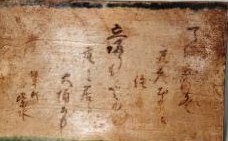
Pottery plaque with the 5th year of Tempo (Kato family collection)

Knot style water jug
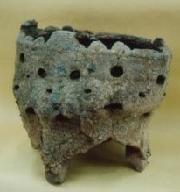
The sayabee used to make Tamagawa ware
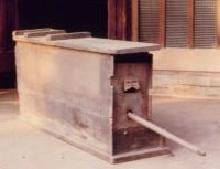
Fuigo used to make Tamagawa ware
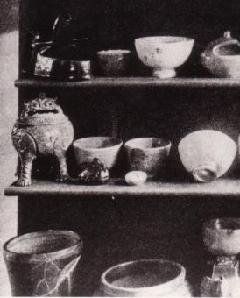
Tamagawa ware collected by Dr. Morse (five items on the left side of the middle row)
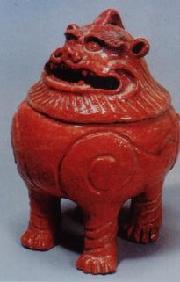
Large lion-shaped incense burner















